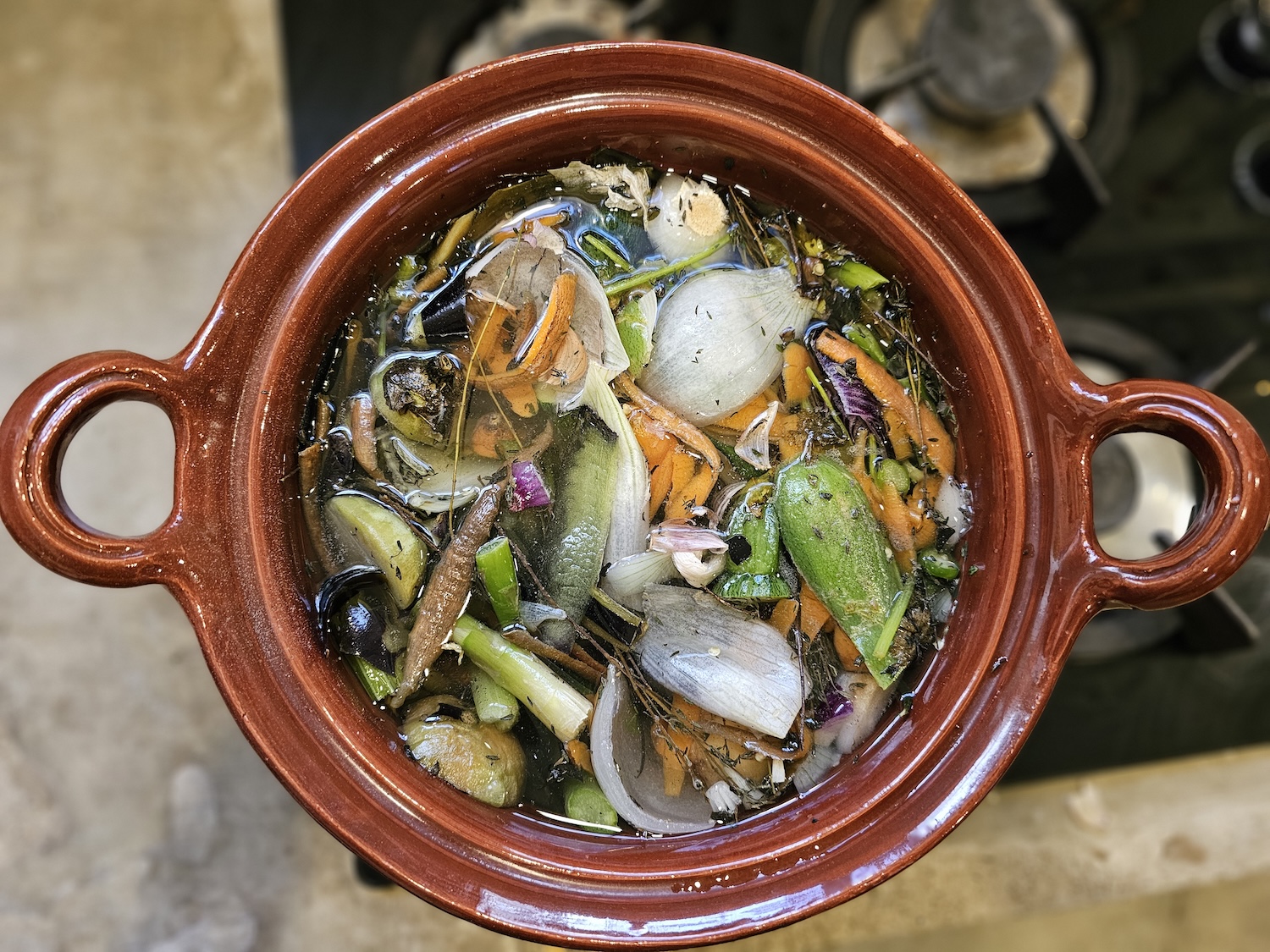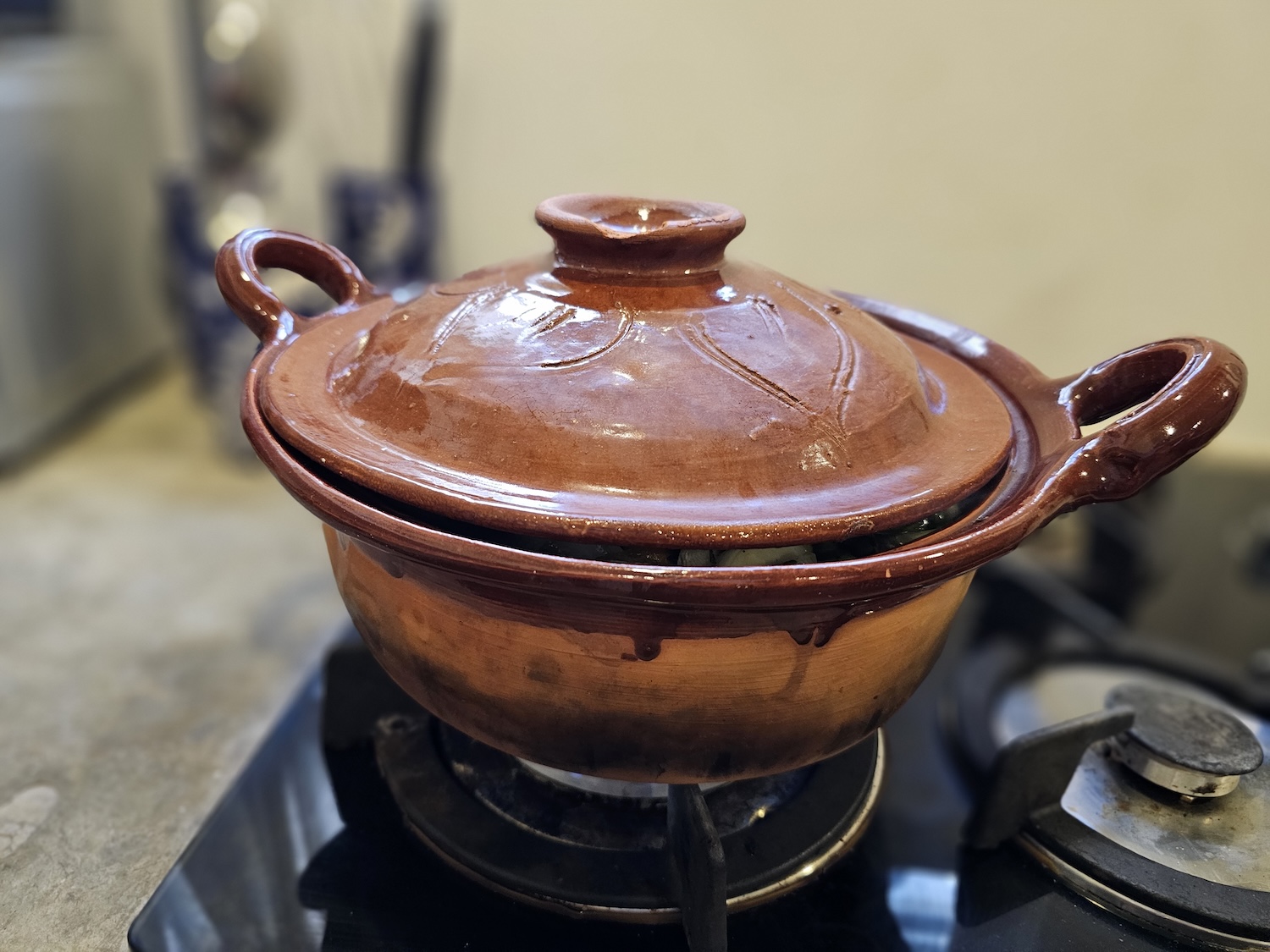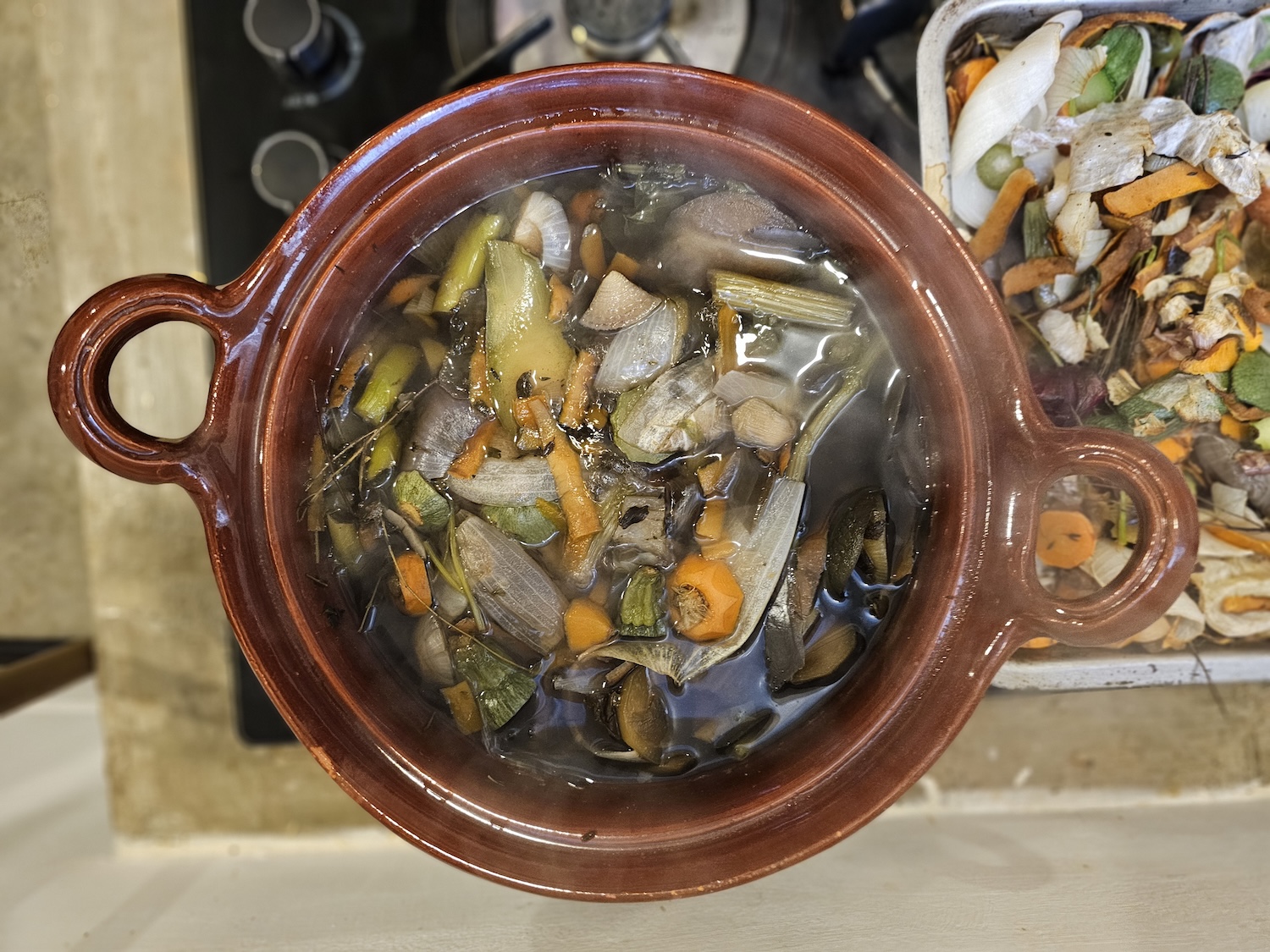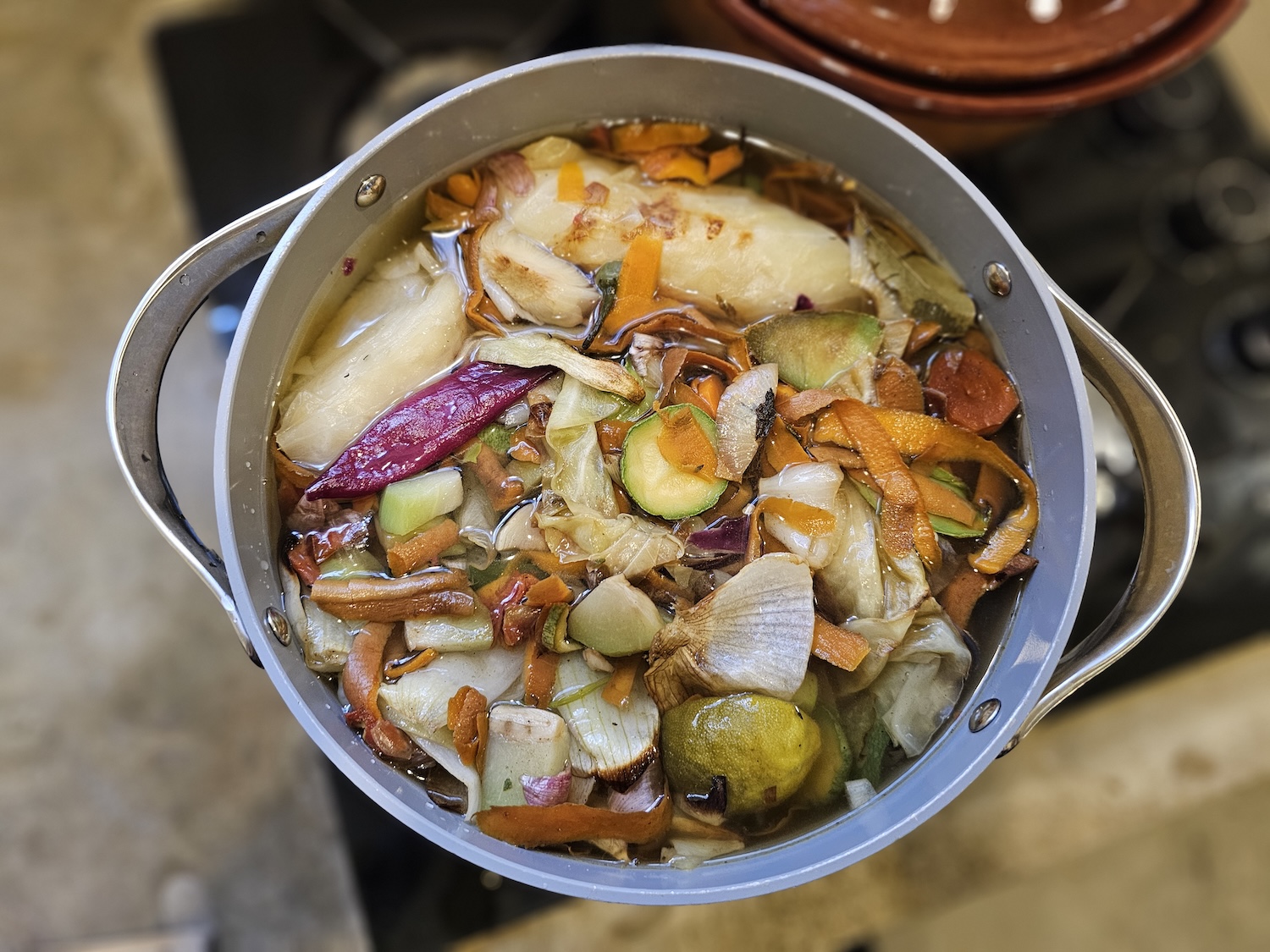
An onion skin here, a carrot top there. The scraps left over from cutting up fresh vegetables may not seem like much, but they can really pile up over time. Trust me, since I started saving mine in the freezer around the holidays, I was shocked by how much accumulated, and a little embarrassed I've never taken the step to save them to make vegetable broth before.
Growing up rurally, we always a had a compost pile, and saving my scraps for homemade stock is one of those things I always "meant to do" since moving to the city, but just never seemed to get around to starting. In the spirit of our 2024 Sustainable Living Challenge, and trying out affordable and accessible things that reduce our personal footprints, I decided to give it a go — and let me tell you, I'm not going back. Read on to learn how it's done, and bookmark this page for when you have enough scraps to start some stock yourself.
How to make vegetable broth from vegetable scraps: Two methods
As you chop and trim, save those scraps in a reusable container or ziplock plastic bag in the freezer. Surprisingly, not all scraps are created equal, and some aren't the best fit for stock. Specifically, scraps from cruciferous vegetables like cabbage, Brussels sprouts, broccoli and cauliflower have a strong flavor that can turn bitter when simmered in stock, so skip those when saving in the freezer. Once your container is full, it's time for the fun part. Making broth at home may sound like a drag, but it's actually much simpler than I imagined and comes together in no time at all.
After a quick web search, I discovered two primary methods to make vegetable broth using scraps: the dump-and-go method, in which you simply cover the scraps with water in a pot on the stove, and another that requires an extra step of roasting those scraps in your oven first.
I could already see a tradeoff coming: Yes, the roasted scraps may lead to a richer broth, but of course it takes longer, requires more cleanup and is a bit more of a pain. To bring you the best advice, I tried both, and I was pretty surprised by the result.
How to make vegetable broth from vegetable scraps: The step-by-step
After saving scraps for about six weeks, I had more than enough to split into two batches. For the first, I simply placed scraps into a pot until it was almost full, covered the scraps with water and placed on the stove to bring to a boil. I used my Mexican clay pot (called a cazuela) for this batch, as it's said to impart a better flavor and I figured it could give the dump-and-go method a fighting chance.

The roasted recipes I read suggested putting scraps on a baking sheet for around 20 minutes at 400 degrees Fahrenheit. From frozen, that didn't seem much time to me, but I was surprised to smell the aroma of roasting veg wafting out of the oven after only a few minutes. On second thought, this makes sense, as of course scraps won't take as long to roast up as a full tray of vegetables.

Same with the non-roasted version: A pleasant, savory smell started coming from the pot before it even came to a boil. Once boiling, loosely cover the pot to allow steam to escape and reduce heat to a simmer.
Some of the recipes I read suggested as little as 20 minutes of simmering time to make vegetable broth, but I really wanted a flavor payoff that made it feel "worth it" to make it myself. Generally with any soup, the longer you cook it, the better it tastes. To give it a full go, I kept the pot simmering longer and tasted every 30 minutes to see how things developed.

Surprisingly, after about 20 to 30 minutes of boiling, I'd say the flavor was about on par with what you'll get with most pre-packaged vegetable broths out there. I let mine simmer for about an hour and a half to see what would happen, but I saw the best flavor and color after about 45 minutes of simmering time — making the dump-and-go method a breeze with almost zero work and less than an hour of waiting.

Once the roasted version is out of the oven, I repeated the same process — putting the roasted scraps in my plain ol' mass-market pot, covering them with water, and bringing to a boil before reducing to simmer and covering loosely with a lid. The water in the pot turned a rich brown color much faster (before even coming to a boil), but I also used warm water to get all the roasty bits off the pans and poured this into the pot as well.

Most recipes indicate you can simmer the roasted version for as little as 20 to 30 minutes too, but I also went a bit longer here to see how flavors would develop.
Once the broth has reached your desired flavor, remove from heat and allow to cool slightly before pouring into a strainer over a heat-resistant bowl. Press down on the scraps to get out as much liquid as you can, and then discard the scraps in the compost bin (if you have one) or in the trash.

The verdict
I'm shocked to say I actually preferred the flavor of the dump-and-go version. The roasted version became very dark in color, which doesn't really bother me since I mostly use broth for cooking beans and making tomato-based soups that already have a deep hue of their own. I also used things like onion skins, which are known to impart a darker color — if you want a paler broth, keep the onion skins out of yours. But beyond the color, I found the dump-and-go version had a cleaner and brighter flavor, while the roasted version tasted a bit more muddled and even slightly bitter.
After doing more research, I also learned that the whole "longer tastes better" thing really applies more to seasoned soups that will richen with the wait and meat stocks that need to break down over longer periods of time. To make vegetable broth with vegetable scraps alone, about 20 to 45 minutes is an ideal time window — any longer, and you could actually lose flavor or risk your broth becoming bitter.
Now knowing this, my "wait and see" method may have led to a slightly more bitter roasted broth, so I'll definitely give both a whirl again to see which I prefer. But the best news for all the scrap-savers out there is that this is one instance where less work and less time can actually yield a better result.
Heck yes for happy accidents and waste reduction. Taking an afternoon to make vegetable broth will be the new fate for all future scraps in my kitchen. What do you guys think? Will you give it a try in yours? Let us know how it gos here!
Into sustainable tips like these? Follow TriplePundit's 2024 Sustainable Living Challenge all year for affordable and accessible ideas to reduce your personal footprint. February is Home Month, where we dive into how to reduce our environmental impact at home and have a little fun while doing it.

Mary has reported on sustainability and social impact for over a decade and now serves as executive editor of TriplePundit. She is also the general manager of TriplePundit's Brand Studio, which has worked with dozens of organizations on sustainability storytelling, and VP of content for TriplePundit's parent company 3BL.














